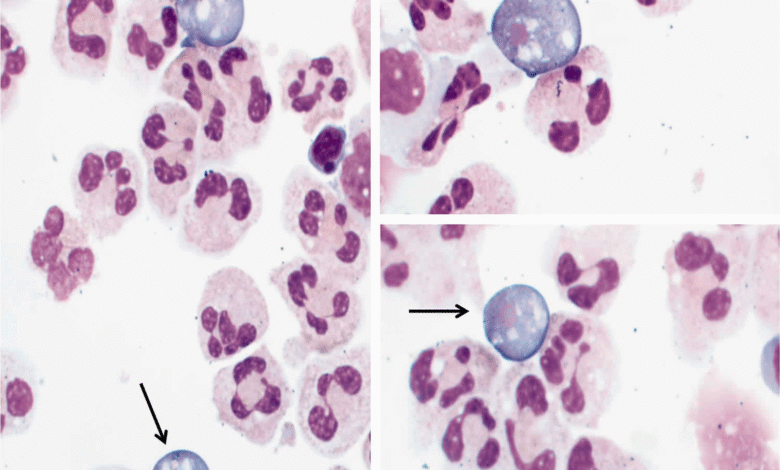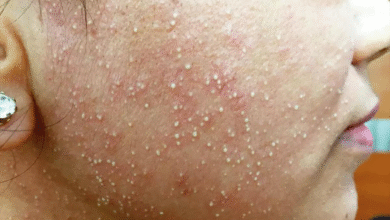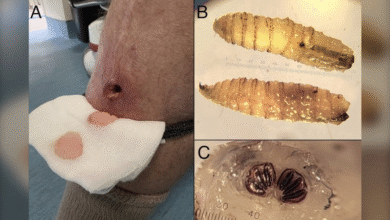Naegleria fowleri: A Rare Brain-Eating Amoeba Case in Missouri

Naegleria fowleri, commonly referred to as the brain-eating amoeba, recently made headlines following the death of a Missouri resident at the Lake of the Ozarks. This rare and devastating organism can lead to primary amebic meningoencephalitis (PAM), a swift and often fatal brain infection that poses significant health risks. Health officials in Missouri have issued alerts urging caution around warm freshwater sources, especially during summer months when the amoeba is most active. Symptoms of Naegleria fowleri infection can rapidly escalate, prompting swift medical attention to improve outcomes. As the state grapples with this alarming incident, the importance of awareness surrounding PAM infections cannot be overstated.
The alarming presence of Naegleria fowleri underscores the dangers posed by the notorious brain-eating amoeba found in warm freshwater environments. This microscopic organism presents substantial health challenges, particularly in lakes and rivers, where recreational activities can unknowingly expose individuals to the risk of infection. Oftentimes referred to as a cause of PAM, symptoms associated with this amoeba can be mistaken for other illnesses, making it crucial for the public to recognize potential signs and seek immediate medical assistance. Recent developments, particularly in areas like the Lake of the Ozarks, have prompted health advisories to protect residents and visitors from this dangerous pathogen. Understanding the risks and implementing preventive measures is vital for those engaging in water-related activities during the warmer months.
Understanding Naegleria fowleri: The Brain-Eating Amoeba
Naegleria fowleri, commonly known as the brain-eating amoeba, is a free-living microscopic organism that poses a serious health risk, especially in warm freshwater environments. This unique amoeba can cause a rare but devastating disease known as primary amebic meningoencephalitis (PAM). Infections typically occur when contaminated water enters through the nose, leading to catastrophic damage to brain tissue. Health authorities stress that while infections are exceptionally rare, the risk is heightened during summer months when temperatures soar, particularly in lakes and hot springs.
In recent incidents, like the unfortunate case at the Lake of the Ozarks, health officials urge individuals engaging in water activities to remain vigilant. Preventive measures, such as pinching the nose shut while water skiing or using nose clips, can significantly reduce the chances of exposure to Naegleria fowleri. Staying informed about the symptoms of Naegleria fowleri, which may include severe headaches, fever, and confusion, is crucial for early detection and swift medical intervention.
Risk of PAM Infection at Lake of the Ozarks
The Lake of the Ozarks in Missouri is a popular recreational destination, but it also presents potential health risks, particularly concerning Naegleria fowleri infections. Warm, still waters provide an ideal habitat for this amoeba, especially during the peak summer months. Over the years, officials have documented cases of PAM infections associated with bodies of freshwater in this area, highlighting the need for public awareness and precautionary measures. Residents and visitors must take responsibility for their safety while enjoying activities such as swimming, skiing, and boating.
Following the recent Missouri health alert regarding the amoeba, health officials are stressing the importance of understanding how to protect oneself from exposure. Recommendations include avoiding submerging the head in water with sediment and ensuring that swimming practices do not stir up potentially contaminated zones. Ensuring community awareness about the dangers posed by the brain-eating amoeba can mitigate risk and promote a safer recreational environment at the lake.
Symptoms of Naegleria fowleri Infection to Watch For
Identifying the symptoms of Naegleria fowleri early can be critical for treatment outcomes. Symptoms of PAM infection typically present themselves within one to twelve days after exposure and can rapidly progress. Initial symptoms resemble those of bacterial meningitis, featuring severe headaches, fever, nausea, and vomiting. As the infection advances, more alarming symptoms may emerge, including stiff neck, seizures, confusion, and even hallucinations. Recognizing these signs promptly is essential since delaying medical evaluation can lead to dire consequences.
Health professionals, such as Tammy Lundstrom, emphasize the significance of seeking immediate medical attention if these symptoms arise following potential exposure to contaminated water. Swift and accurate diagnosis can aid in administering the appropriate combination of antifungals and antibiotics, as timely medical intervention can drastically affect survival rates. Thus, staying informed about the symptoms of Naegleria fowleri is key for anyone engaging in outdoor water activities.
Precautionary Measures Against Naegleria fowleri
To safeguard against potential infections from the brain-eating amoeba, individuals engaging in freshwater activities should adhere to specific precautionary measures. Health officials recommend using nose clips while diving or water skiing, which can effectively prevent water from the pool or lake from entering the nasal passage. Additionally, avoiding warm shallow waters where sediment is disturbed can decrease the risk of exposure. Such measures are especially important after heavy rains, which can stir up contaminated sediment.
Public awareness campaigns by the Missouri health department emphasize the rarity of Naegleria fowleri infections but stress that when they do occur, they are often fatal. This dual message aims to instill both caution and confidence in recreational water activities. Individuals should also consider alternative activities that reduce the chance of exposure, such as opting for chlorinated swimming pools, which are less likely to harbor the amoeba.
The Importance of Community Awareness about Naegleria fowleri
Community education plays a crucial role in combating the dangers posed by Naegleria fowleri. Informing both local residents and tourists about the risks associated with freshwater activities can lead to better preventive practices and ultimately save lives. Local authorities and health departments are tasked with distributing accessible information that details preventive measures and symptoms to monitor. By raising awareness, the community can collectively reduce the incidence of PAM infections during peak swimming seasons.
Health alerts, like the recent notification from Missouri health officials, serve as impetus for local awareness initiatives. Collaborations between health agencies and recreational facilities can facilitate workshops, distribution of safety brochures, and information sessions that educate the public about the brain-eating amoeba. As discussions around Naegleria fowleri become more common, it empowers individuals to take proactive steps in ensuring their safety while enjoying the natural beauty of lakes and rivers.
Treatment Options for Naegleria fowleri Infections
When diagnosed with a Naegleria fowleri infection, swift treatment is essential due to the rapid progression of PAM. Conventional treatment often involves a combination of antifungal medications such as amphotericin B along with specific antibiotics like rifampin and azithromycin. Though treatment outcomes can be grim, especially given the rapidity of the disease, earlier intervention improves chances of survival. Understanding these treatment options can provide a glimmer of hope for families facing this severe condition.
Recent advancements in research are focusing on exploring new therapies to combat the brain-eating amoeba. Continuous studies aim to uncover effective strategies to enhance the efficacy of existing medications. Moreover, educating healthcare professionals about recognizing the symptoms in a timely manner can be a game-changer, allowing for earlier diagnosis and intervention that could make a critical difference in patient outcomes.
Infrequent but Fatal: Statistics on Naegleria fowleri
Statistical data indicates that Naegleria fowleri infections, while incredibly rare, are nearly always fatal. Since 1962, the CDC has documented fewer than 10 cases annually across the United States, with a total of about 167 cases. Missouri itself has reported only two previous cases, which underscores the rarity of exposure relative to the population. Understanding these statistics emphasizes the importance of awareness regarding the amoeba’s risk factors and serves as a reminder of the tragic results that can follow infection.
Health officials utilize these statistics to communicate effectively with the public, clarifying that while the risk of infection is low, the severity when it does occur cannot be overstated. Establishing this balance helps to create a culture of caution without causing unnecessary fear. By disseminating factual data about Naegleria fowleri, stakeholders can enhance public education and ultimately contribute to safer recreational practices.
Missouri Health Alerts: Staying Informed
In response to the tragic incident at the Lake of the Ozarks, Missouri health officials have released health alerts and guidelines to keep the public informed about Naegleria fowleri. Communicating potential risks and preventive measures enables residents and visitors to take necessary precautions while enjoying water-based activities. Health alerts also ensure that information on symptoms and urgent care is widely disseminated, empowering individuals to act swiftly if they experience signs of infection.
Continual updates from health departments are vital, especially during peak swimming seasons. These alerts serve as timely reminders for the public to stay vigilant and educated. The need for a proactive approach in health communication cannot be overstated, given the potential risks associated with freshwater exposure. Stakeholders within the community, including local health officials, should strive to maintain open lines of communication in order to effectively address public health concerns.
Promoting Safe Recreational Practices in Freshwater Bodies
To cultivate a safe environment for recreational activities in freshwater bodies, individuals must adhere to safe practices while swimming or relaxing near lakes and rivers. Health officials recommend tips like checking local water quality reports, avoiding stagnant water, and being aware of temperature changes that could encourage Naegleria fowleri growth. By fostering a culture of safety, communities can help minimize the risk of brain-eating amoeba exposure.
Communities should also encourage the development of infrastructure that promotes safety, such as installing adequate signs at lakes that inform swimmers about the risks associated with Naegleria fowleri. Collaborating with environmental agencies to monitor water quality could enhance public safety. These collective measures are vital for ensuring that recreational activities can be enjoyed safely while minimizing health risks associated with the brain-eating amoeba.
Frequently Asked Questions
What is Naegleria fowleri and how does it cause PAM infection?
Naegleria fowleri, often referred to as the brain-eating amoeba, is a microscopic organism found in warm freshwater sources like lakes and rivers. Infection occurs when water containing the amoeba enters the nose, allowing it to travel to the brain and lead to primary amebic meningoencephalitis (PAM), a severe and often fatal brain infection.
How can I prevent infection from Naegleria fowleri while swimming at the Lake of the Ozarks?
To prevent Naegleria fowleri infection while enjoying activities at the Lake of the Ozarks, pinch your nose shut or use plugs when swimming, avoid stirring up sediment in warm shallow waters, and do not submerge your head in hot springs. It’s also advisable to use distilled or boiled water for any nasal rinsing.
What are the common symptoms of Naegleria fowleri (PAM infection)?
The symptoms of Naegleria fowleri infection, or PAM, can appear within one to 12 days after exposure. Common symptoms include severe headache, fever, nausea, vomiting, stiff neck, confusion, hallucinations, and seizures. Early symptoms are similar to those of bacterial meningitis, and immediate medical evaluation is crucial.
Are infections from Naegleria fowleri common in Missouri?
Infections from Naegleria fowleri are extremely rare in Missouri, with only two documented cases prior to the recent incident. Nationwide, there have been fewer than 10 reported cases each year, with a total of 167 cases recorded since 1962. Health officials emphasize the rarity of these infections.
Is Naegleria fowleri transmissible from person to person?
No, Naegleria fowleri is not contagious and cannot be transmitted from person to person. Infection occurs solely through exposure to contaminated water entering the nose, often in warm freshwater settings like lakes or rivers.
What treatments are available for a Naegleria fowleri infection?
Treatment for Naegleria fowleri infection typically involves administering antifungal medications and antibiotics such as rifampin and azithromycin. However, the infection is often fatal, highlighting the importance of early recognition and prevention.
What conditions increase the risk of Naegleria fowleri infection at the Lake of the Ozarks?
The risk of Naegleria fowleri infection increases in water temperatures ranging from 80 to 115 degrees Fahrenheit, especially after storms. Engaging in water activities during warm months and stirring up sediment in lakes also heightens the risk of exposure.
What should I do if I experience symptoms of Naegleria fowleri after swimming?
If you experience symptoms such as severe headache, fever, or stiff neck after swimming in warm freshwater, seek immediate medical evaluation. These symptoms can resemble bacterial meningitis and require prompt attention.
What is the latest Missouri health alert regarding Naegleria fowleri?
The latest Missouri health alert highlights a recent fatal case of Naegleria fowleri linked to water activities at the Lake of the Ozarks. Health officials recommend taking precautions while swimming and being aware of the symptoms associated with PAM to ensure safety.
| Key Point | Details |
|---|---|
| Death from Naegleria fowleri | A Missouri resident died after contracting the brain-eating amoeba at Lake of the Ozarks. |
| Symptoms of Infection | Symptoms may include severe headache, fever, nausea, vomiting, stiff neck, seizures, confusion, and hallucinations. |
| Transmission | The amoeba infects individuals when water enters the nose, usually during water activities in warm freshwater sources. |
| Rarity of Cases | Fewer than 10 cases of Naegleria fowleri are reported annually in the U.S.; only 167 cases have been documented since 1962. |
| Preventive Measures | Avoid stirring up sediment, pinch the nose while swimming, and use distilled or boiled water for sinus rinses. |
| Treatment Options | Treatment includes antifungal medications and antibiotics like rifampin and azithromycin. |
Summary
Naegleria fowleri is a concerning and often fatal amoeba that can cause primary amebic meningoencephalitis (PAM) when contracted through warm freshwater. This unfortunate case in Missouri highlights the importance of being vigilant while engaging in water sports in environments where the amoeba thrives. Understanding the symptoms and prevention methods is crucial for safety, as infection from Naegleria fowleri remains exceptionally rare, though deadly.




